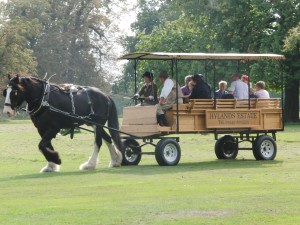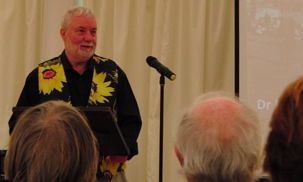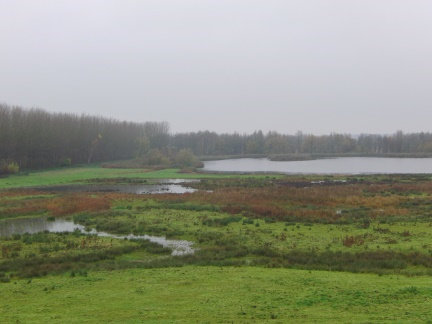
A small group of Fellows were this week able to take advantage of an invitation to visit and see the work of the team at Kingfishers Bridge Wetland Project .
Situated close to Wicken Fen, this sanctuary, developed from privately held land, is both a successful conservation area and a test-bed for experimental conservation methodologies.
James Page and Andy Dunn gave fellows a guided tour through the conservation landscape, which was both informative and telling about the efficacy of landscape management of this high order. Some of the insights we gained are offered below.
The Project team manage a wide variety of habitats in a relatively small area. The topography of the site falls away from a limestone ridge, which itself is an ancient coral reef, through chalk grassland areas and peat deposits. There is a plethora of lake-side, dyke margin and reed bed coverage across the site too.
Clay banks are used to prevent site inundation, the area being part of the River Cam flood plain. There is an interesting spoil mound, with a track rising to the summit, where viewing ‘hides’ are to be found and the view from the top offers great views of both the whole of the wetlands project area, but also across the surrounding fen and river network.
This surrounding area is typical grass wetland, with some of the tree cover being recently removed, and the new development includes ponds which are linked to the agricultural drainage ditches. The whole water course development is designed to remove straight lines from the landscape. These betray the sites farmland origins, but the additional work also denies predatory birds a clear flight path to their prey.
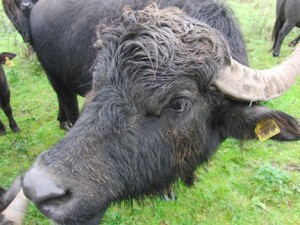
One really interesting aspect of the grazing management is the deployment of Konic horses, the Polish primitive horse, as well as a small herd of Water Buffalo. This latter creature is adept at exploring the reed beds across the conservation site, and its dietary habits keep the reed beds appropriately cropped and seasonally refreshed…with appropriate site management control, of course.
As a closed site, water management is a key aspect of managing the rise and fall of levels across the seasons. The setting clay banks and ‘elbow pipe’ systems simply divert water which is drawn from a nearby limestone quarry, a simple system which regulates levels and flow across the reserve.
This aquatic draw down from their neighbour allows Kingfishers Bridge to draw in alkali water, which is nutrient free, stimulating the growth of the site’s invertebrate population. The entire site is surrounded by an impressive electric fence, which serves to keep predators away from the reserve areas.
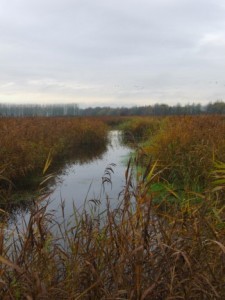
It is clear that this thoughtful, well managed approach to conservation across the bio-chain is a significant constituent to the success of the reserve. This ‘sanctuarial’ approach, with a well managed predator control/exclusion programme, see herons nesting on the site and a wide variety of birds, bats and plant life proliferating to interest the invited visitor.
One wonderful example of how this management expertise can transform the landscape is the Water Germanda (Teucrium scordium L.) The Kingfishers Bridge site held the last twelve plants of the species in the East of England. Water management techniques on the site now see, it is currently estimated, over two million specimens growing in the wider landscape.
We understand the site is keen to develop their support of educational visits from schools. it was profoundly satisfying to hear that the conservation team at Kingfishers Bridge actively engage children and young people in site measurement and surveys. A process which enables children to actively contribute real data to the site management process.
To explore educational visit opportunities further you can find the Kingfishers Bridge Contact Us page here – http://www.kingfishersbridge.org/contact-us.html
The adult volunteer and supporter is not left out either. Supporters of the project can gain exclusive access to project services, as well as make their own contribution to site surveys and measurements.
The Project does seek donations to keep the good work going and you can find both work party information and how to donate as a Project Supporter here – http://www.kingfishersbridge.org/how-to-help.html
Specific development projects are dependent upon sponsorship and the ‘Kingfishers’ team would be happy to explore their current opportunities with interested supporters.
Whether as a Fellow with a bio-science specialism, or as a passionate general supporter of eco-conservation projects, there is much to delight and do in concert with the Kingfishers Bridge team. (We really enjoyed our morning in the Fen..Ed).
Kingfishers Bridge Wetland Creation Trust,
Kingfishers Bridge, Wicken, Ely, Cambs. CB7 5XL
Charity No 1078882
Discover the project on-line – http://www.kingfishersbridge.org/
Fellows in the East of England are able to take part in a range of events and occasions. Visit our pages regularly, subscribe to our newsfeed or bookmark our regional events programme web page here…




